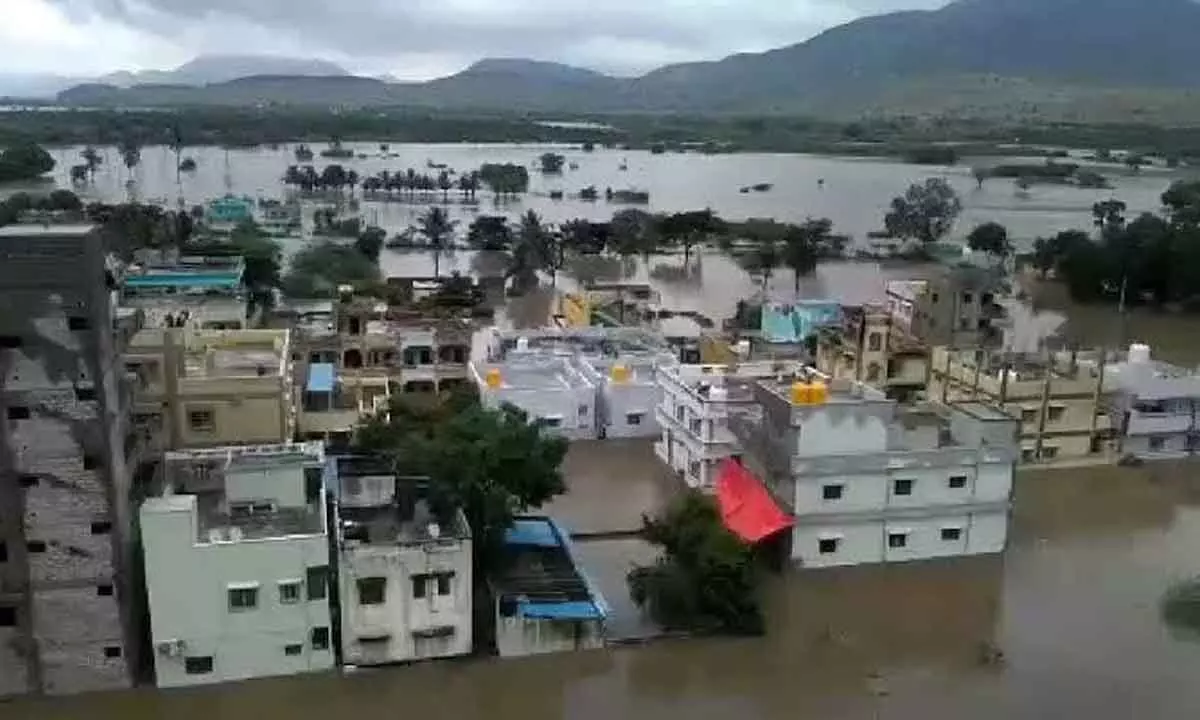Live
- Manipur violence: Assam Police mount 24x7 vigil along inter-state border
- The Impact of Wellness Programs on Employee Engagement and Retention
- IS claims responsibility for deadly attack in Afghanistan
- The Future of MSMEs: Embracing Innovation and Sustainability for Growth
- Army chief returns from Nepal after defence cooperation talks
- ‘Vikatakavi’ shines at IFFI, Goa
- Tamannaah highlights the strengths of south Indian cinema
- Shivanna’s ‘BhairathiRanagal’ locks Telugu release date
- Startup Ecosystem and Technology: Revolutionizing India’s Retail Fashion
- SDT’s ‘Satya’looks favorite at Filmfare Short Film Awards 2024
Just In
Poor drainage system blamed for flooding in Anantapur


The recent urban flooding in the twin districts particularly in Anantapur residential areas highlighted the poor drainage system, illegal constructions and encroachment of water bodies.
Anantapur-Sathya Sai: The recent urban flooding in the twin districts particularly in Anantapur residential areas highlighted the poor drainage system, illegal constructions and encroachment of water bodies. Last two days the town was battered by rains that were unprecedented in scale and floods that were disastrous in impact. While the rains have abated, thousands living on the periphery of Pandameru, Tadakaleru, Maruva Vanka, Nadimi Vanka lakes in west Anantapur are still gripped by fear, worried that deliberately narrowed drains, encroachment of wetlands and state apathy could trigger another round of devastation.
The drains have shrunk from about 120 feet to 60 feet along several flood-prone stretches along Nadimi Vanka and Maruva Vanka. Nadmivanka, which was 120 feet wide, has been narrowed down to just 40 feet, several encroachments and temples were built. Many social activists complained several times to clear the silt under it, but they went unheeded.
"Everyone knows why the drains get clogged, the reason being dumping of solid waste and construction debris. Additionally, the unregulated inflow of raw sewage continues unabated. When the drains overflow, the drinking water lines get contaminated," stated T Satyanarayana, a resident of Bellary road. "The piped water stinks. We end up spending thousands on cleaning our storage tanks and sumps. Problems associated with urban floods range from relatively localised incidents to major incidents, resulting in cities being inundated from hours to several days. Therefore, the impact can also be widespread, including temporary relocation of people, damage to civic amenities, deterioration of water quality and risk of epidemics," he said.
Municipal Commissioner Bhagyalakshmi told 'The Hans India' that reports of encroachment of Nadimivanka and Maruvanka will be verified by the revenue and irrigation department. This will be taken to the notice of Collector and an inter-departmental committee will be constituted to formulate action plan and prevent the recurrence of a similar situation again, she assured.
The government should take remedial measures to tackle the menace of urban flooding, feels members of residential welfare associations. Speaking to The Hans India, Federation of Residents Welfare Associations president Suresh Babu observed that flooding in urban and semi-urban areas were happening due to unplanned waste dumping and continuous disregard for natural recharge structures like ponds, wetlands, and tanks.
Urban flooding is significantly different from rural flooding as urbanisation leads to developed catchments, which increases the flood peaks from 1.8 to 8 times and flood volumes by up to 6 times.
Consequently, urban flooding occurs very quickly due to faster flow which is in a matter of minutes. Urban areas are densely populated and people living in vulnerable areas suffer due to flooding, sometimes resulting in loss of life. It is not just flooding but the secondary effect of exposure to infection also has its toll in terms of human suffering, loss of livelihood, and in extreme cases, loss of life.
In the recent flood in Anantapur, hundreds of houses were submerged causing even monetary loss. City planners say flooding in urban and peri-urban areas are happening due to unplanned constructions, meteorological —rainfall frequency and intensity, storms, temperature and hydrological factors — groundwater levels, extent of impervious surface). When combined with anthropogenic factors in urban centres, they are classified as urban floods. Anthropogenic factors like land-use changes, exploitation of floodplains by construction and similar activities, poor solid waste management and destruction of drainage, complicate the system. For lower income groups, another challenge is the ability to earn a livelihood, which gets directly affected by urban flooding. It shows how urban poor are more at risk.

© 2024 Hyderabad Media House Limited/The Hans India. All rights reserved. Powered by hocalwire.com






